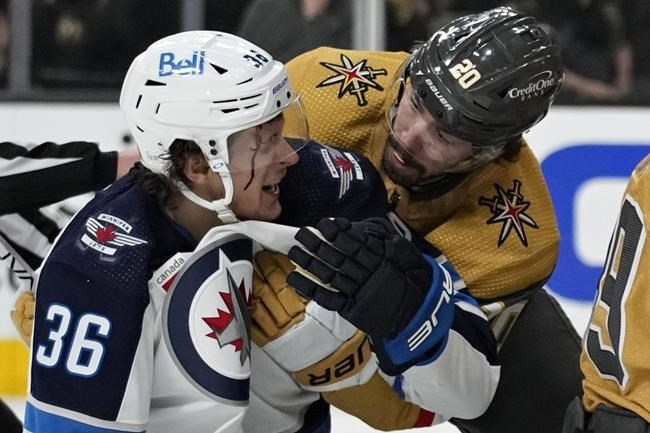Morgan Barron's stitched face sends a shudder through his NHL brethren, but players find the idea of more facial protection equally distasteful.
While many players have voluntarily adopted cut-resistance socks and wristbands, they've historically met any augmentation of head gear with resistance.
Barron is currently playing with a full cage because he was cut for 75 stitches in Game 1 of his Winnipeg Jets playoff series against the Vegas Golden Knights.
Knight's goalie Laurent Brossoit's skate blade jammed into the space between Barron's face and his half-visor during a goalmouth scramble.
Vertical stitches run from the top of Barron's forehead to the corner of his right eye. Reduced swelling has left a rainbow of bruising to enhance his bar-fight look.
"Oh man, goalies sharpen their skates really sharp, too," Toronto Maple Leafs defenceman Mark Giordano said. "That's what's scary about it.
"Goalies have sharp skates because they have to catch their edge all the time. It was such a tough play for (Barron). It was almost like in slow motion. It felt like he couldn't avoid it. Thank god he's OK and it was wasn't anywhere in the eye."
"Freak accident" and "knock on wood" was a common refrain from players when asked about Barron's face.
"Definitely saw it. Super-unfortunate event and glad the guy's OK because that was really scary," Edmonton Oilers captain Connor McDavid said. "Any time you're around the eye, it's obviously a little bit scary.
"That being said, it's a fast game out there. Those things can happen. Those things tend to not happen, knock on wood. It's kind of a one-off-situation, I guess."
Players don't want any encumbrances their eyes might have to adjust to, or look around, to see what's happening on the ice.
They'll don a cage or full shield for as short a time as possible after a facial injury, in order to protect that area and continue playing.
"I'd like to be back in the (half) visor and hopefully I will be kind of soon just to get a clearer visibility out there, but it's not too bad," Barron said.
The idea of increasing facial protection generally was met with a shake of the head.
"I would say no. I'm pretty satisfied with the facial protection," Oilers forward Evander Kane said.
"When you have to put a cage on sometimes, guys look forward to getting rid of that as soon as possible. I don't think there would be a big appetite for the players with that."
Said Barron: "I'd rather be back in a visor for the time being, to be honest with you. Just the visibility is so much better. Wearing a mouth guard is another thing. I can't wear a mouth guard in a cage. It's too much work to take it in and out on the bench."
Such has been players' reluctance to add anything above the neck that the NHL had to grandfather in both helmets and half-visors over time to make both standard.
Over 30 years after helmets became mandatory, the NHL instituted in 2013-14 half-visors for players with fewer than 25 games of experience.
Gruesome eye injures to both Bryan Berard (2000) and Manny Malhotra (2011) dented arguments against it.
But as was the case with helmets — Craig McTavish famously played his last season in 1997 without one — there are still a few half-visor holdouts.
"I wish it wasn't grandfathered in for the visors," said Toronto's Ryan O'Reilly, who is one of the few left playing barefaced. "I've been without it for many, many years now. It's just comfort. It makes it easier for me to play."
There's a marketing argument against more facial protection, Tampa Bay Lightning coach Jon Cooper said, because fans want to see the players' faces.
"These are star athletes. If you cover up their face, who would you recognize as a star athlete?" Cooper asked. "You want the fans to be able to see your players and expressions and who we are.
"Do you want to be introduced to Connor McDavid one day and say, 'Well, oh my god, this first time I've seen what you look like?'
"These are contact sports. There's so much prevention going on all over the place, but you can't look after every single injury. It's unbelievably unfortunate what happened to the poor kid in Winnipeg, but it's not a norm in our game."
NHL players from the NCAA wore either a full cage or full face shield during their college careers. Winnipeg's Nate Schmidt did at Minnesota, but doesn't want to in the NHL because he thinks it could make players reckless.
"I hope not," Schmidt said. "If you start having guys with cages, you're going to have sticks flying all over the place, guys diving face-first into things and taking things in throats.
"A lot of times guys will turn their heads. They'll protect their face a little more now. If you have full shield, guys don't care. They'll run headfirst into things."
Junior A leagues across Canada will be played with full facial protection by 2025-26 at the behest of Hockey Canada.
A phasing in starts next season with players aged 16-18 required to wear it, although both the Ontario Junior Hockey League in 2016 and the Northern Ontario Junior Hockey League in 2020 have already adopted cages and full shields.
The day players reach a level of hockey where they can shed full facial protection feels like a rite of passage for them. They don't want to go back.
"I think visors are where it's going to stop for a while," Giordano said.
— With files from Joshua Clipperton and Judy Owen
This report by The Canadian Press was first published April 25, 2023.
Donna Spencer, The Canadian Press



